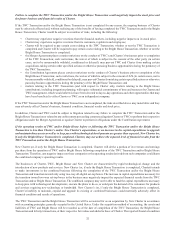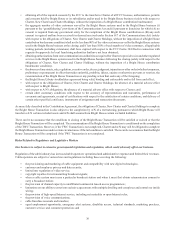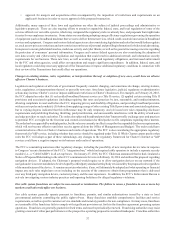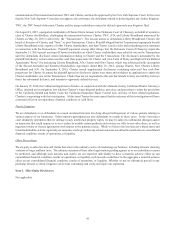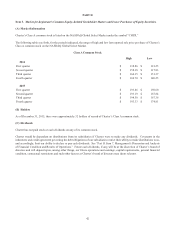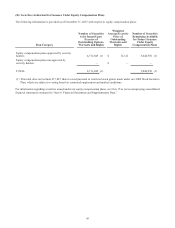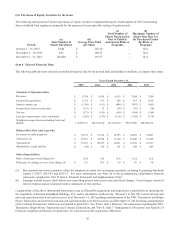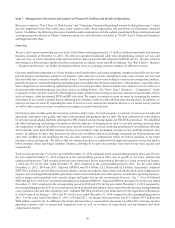Charter 2015 Annual Report Download - page 55
Download and view the complete annual report
Please find page 55 of the 2015 Charter annual report below. You can navigate through the pages in the report by either clicking on the pages listed below, or by using the keyword search tool below to find specific information within the annual report.40
rural call completion reporting, disability access and discontinuance of service requirements. In addition, the FCC is subjecting
our VoIP services to new back-up power obligations that were effective beginning February 2015.
In 2011, the FCC released an order (subsequently upheld on appeal) that significantly changed the rules governing intercarrier
compensation payments for the origination and termination of telephone traffic between carriers, including VoIP service providers
like us. This change will result in a substantial decrease in intercarrier compensation payments over a multi-year period.
Item 1B. Unresolved Staff Comments.
None.
Item 2. Properties.
Our principal physical assets consist of cable distribution plant and equipment, including signal receiving, encoding and decoding
devices, headend reception facilities, distribution systems, and customer premise equipment for each of our cable systems.
Our cable plant and related equipment are generally attached to utility poles under pole rental agreements with local public utilities
and telephone companies, and in certain locations are buried in underground ducts or trenches. We own or lease real property for
signal reception sites, and own our service vehicles.
Our subsidiaries generally lease space for business offices. Our headend and tower locations are located on owned or leased parcels
of land, and we generally own the towers on which our equipment is located. Charter Holdco owns the land and building for our
St. Louis corporate office. We lease space for our corporate headquarters in Stamford, Connecticut.
The physical components of our cable systems require maintenance as well as periodic upgrades to support the new services and
products we introduce. See “Item 1. Business – Our Network Technology.” We believe that our properties are generally in good
operating condition and are suitable for our business operations.
Item 3. Legal Proceedings.
On February 14, 2014, Comcast and TWC announced their intent to merge. Shortly thereafter, Breffni Barrett and others filed
suit in the Supreme Court of the State of New York for the County of New York against Comcast, TWC and their respective officers
and directors. Plaintiffs alleged, among other things, that the TWC and Comcast boards of directors breached their fiduciary duties
to their respective stockholders during merger negotiations by entering into the merger agreement and approving the merger; and
that TWC, Comcast and the holding company created to merge the companies aided and abetted such breaches of fiduciary duties.
Plaintiffs further alleged that the joint proxy statement/prospectus filed by Comcast with the SEC on March 20, 2014, which
contained the preliminary proxy statement of TWC, was misleading or omitted certain material information. Seven other similar
class actions were filed in February and March 2014 in courts in New York and Delaware making similar allegations, and five of
these were consolidated with this matter. The complaints sought injunctive relief enjoining the stockholder vote and merger,
unspecified declaratory and equitable relief, compensatory damages in an unspecified amount and costs and fees. On July 22,
2014, those parties entered into a memorandum of understanding ("MOU") to settle the suits. That MOU, which was subsequently
amended, was subject to final approval by the New York Supreme Court and certain other conditions. However, in April 2015,
Comcast and TWC terminated their proposed transaction, which terminated that settlement. On May 26, 2015, Charter and TWC
announced their intent to merge.
On June 29, 2015, the parties in the NY Actions filed a stipulation agreeing that plaintiffs could file a Second Consolidated Class
Action Complaint (the “Second Amended Complaint”), and dismissing the action with prejudice as to Comcast and Tango
Acquisition Sub, Inc. After the court so ordered the stipulation, the plaintiffs in the NY Actions filed the Second Amended Complaint
on July 1, 2015. The Second Amended Complaint named as defendants TWC, the members of the TWC board of directors, Charter
and the merger subsidiaries. The Second Amended Complaint generally alleges, among other things, that the members of the TWC
board of directors breached their fiduciary duties to TWC stockholders during the Charter merger negotiations and by entering
into the merger agreement and approving the mergers, and that Charter and its subsidiaries aided and abetted such breaches of
fiduciary duties. The complaint sought, among other relief, injunctive relief enjoining the stockholder vote on the mergers,
unspecified declaratory and equitable relief, compensatory damages in an unspecified amount, and costs and attorneys’ fees.
On September 9, 2015, the parties entered into an MOU to settle the action. Pursuant to the MOU, defendants issued certain
supplemental disclosures relating to the mergers on a Form 8-K, and plaintiffs agreed to release with prejudice all claims that
could have been asserted against defendants in connection with the mergers. The settlement is conditioned on, among other things,




